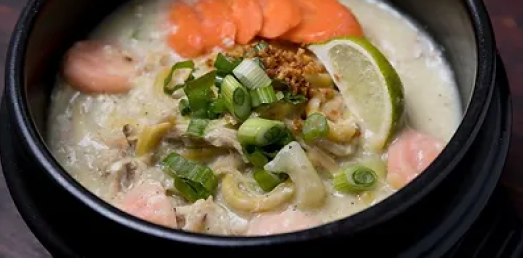Roc's Blog


Delicious Cakes
The must-try Kare-Kare Wings. Simple yet addicting, unique but satisfying. It’s the talk of the town. Wanna try something new? Come and get it at Roc’s Grill!


Kare-Kare Wings
I know you’re drooling. From the top left to the right: Sansrival, Taro Cake, Choco Yema, and Yema Cake. Choose your indulgence!


Lomi Ala Eh
The crowd’s fave Lomi Ala Eh, made of thick Canton noodles, shredded chicken, seafood balls, carrots, fried garlic, egg, and lime, is cooked straight from the pot so it’s boiling hot when served, perfect for this long lingering winter. Come try it at rocs where it’ll surely warm you up!
Exploring Filipino Cuisine: A Culinary Journey Through Cultural Fusion
Have you ever pondered over the intricate blend of flavours that make up Filipino cuisine? Join us on a journey to uncover the fascinating stories behind the dishes that reflect the rich cultural heritage of the Philippines. From Malay roots to Spanish, Chinese, and American influences, Filipino cuisine offers a tantalizing fusion of flavours that’s sure to captivate your palate. How much do you know about the culinary tapestry that defines Filipino cooking? Let’s delve into the delicious details together!


Understanding Cultural Fusion:
Filipino cuisine is a beautiful mosaic of flavors, shaped by centuries of cultural exchange and adaptation. At the core of Filipino cooking lies the concept of Cultural Fusion, where influences from various culinary traditions seamlessly blend together to create something unique. From the indigenous flavors of the Malay archipelago to the Spanish, Chinese, and American influences brought by centuries of colonization and trade, Filipino cuisine is a testament to the country’s rich and complex history.


Malay Roots:
The foundation of Filipino cuisine can be traced back to its Malay roots, with dishes like adobo, sinigang, and kinilaw showcasing the use of indigenous ingredients and cooking techniques. These dishes reflect the simplicity and resourcefulness of early Filipino settlers, who relied on local ingredients to create flavorful and nourishing meals.


Spanish Influence:
The Spanish colonization of the Philippines introduced a wealth of new ingredients and cooking methods to Filipino cuisine. Dishes like lechon, paella, and caldereta bear the unmistakable mark of Spanish influence, incorporating ingredients such as tomatoes, garlic, and onions, as well as cooking techniques like stewing and braising.


Chinese Legacy:
Chinese immigrants have played a significant role in shaping Filipino cuisine, introducing ingredients such as soy sauce, tofu, and noodles, as well as cooking methods like stir-frying and steaming. Dishes like pancit, lumpia, and siopao highlight the fusion of Filipino and Chinese culinary traditions, resulting in dishes that are both familiar and uniquely Filipino.


American Influence:
The American occupation of the Philippines in the early 20th century brought with it a new wave of culinary influences, including dishes like fried chicken, burgers, and spaghetti. While these dishes may have originated elsewhere, Filipinos have embraced them wholeheartedly, putting their own spin on classic American favorites to create dishes like Jollibee’s spaghetti and Chickenjoy.


